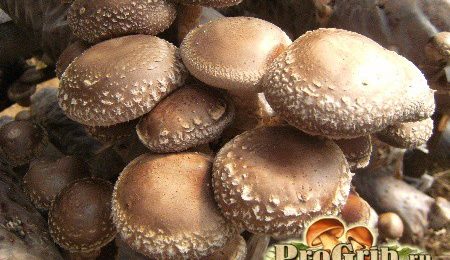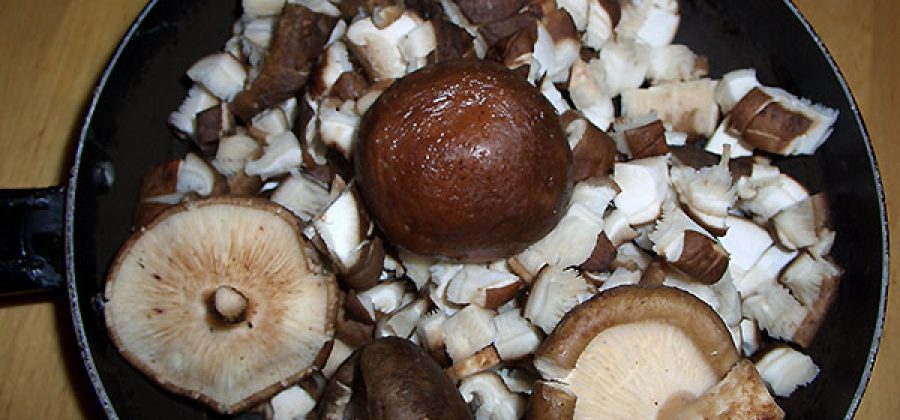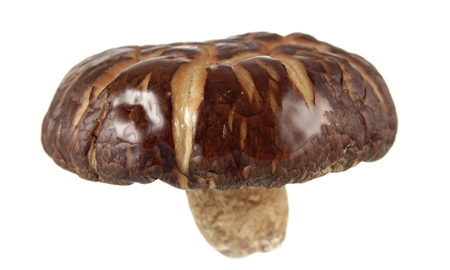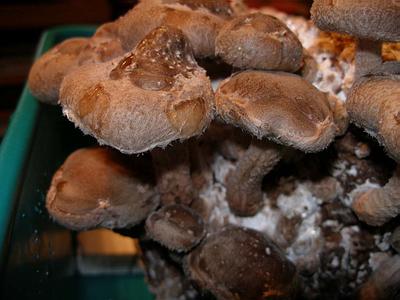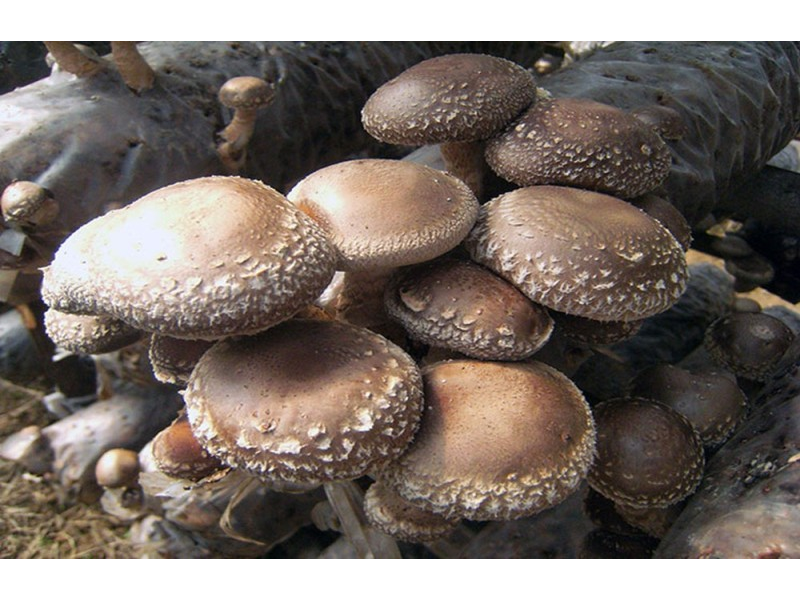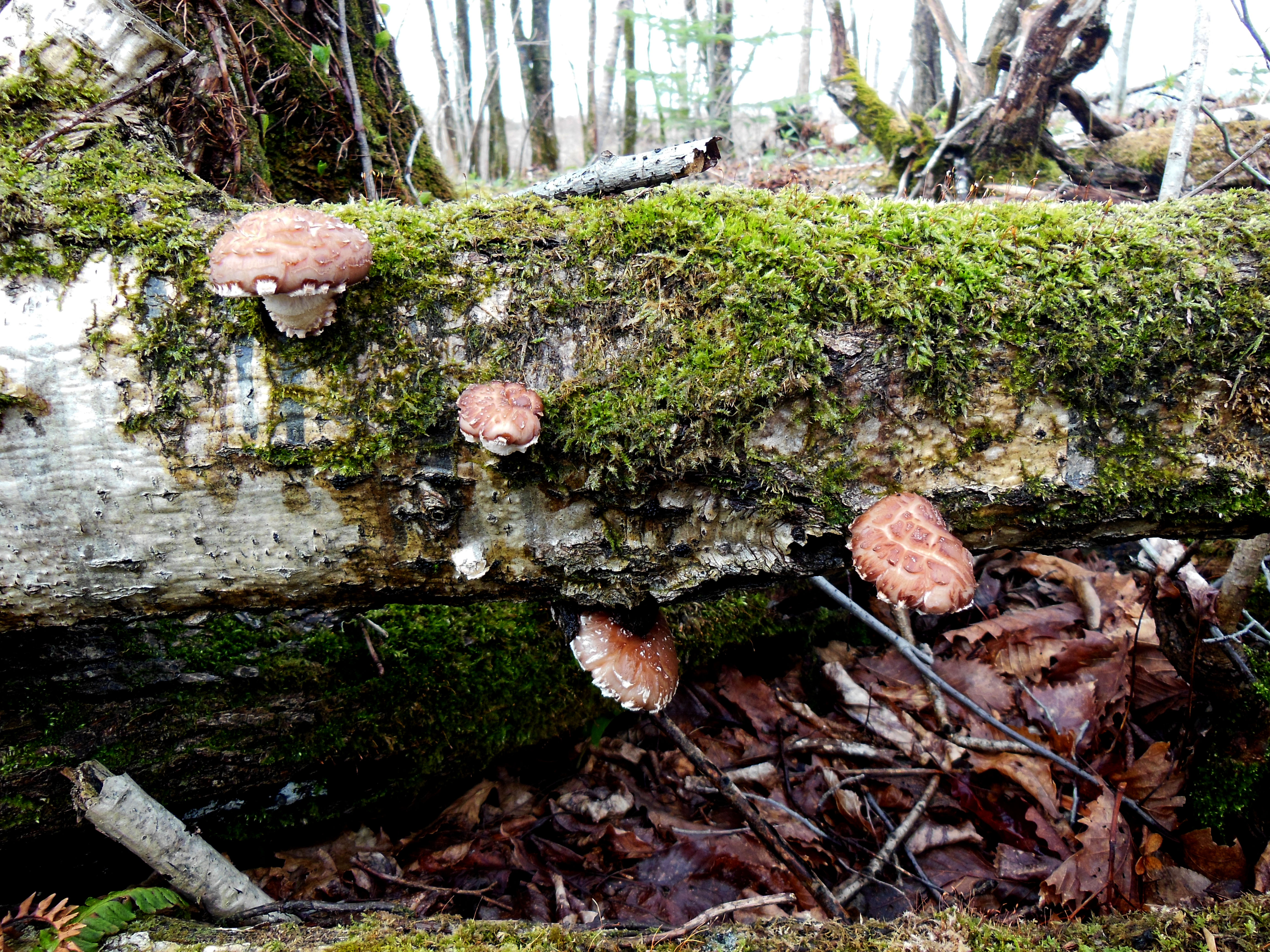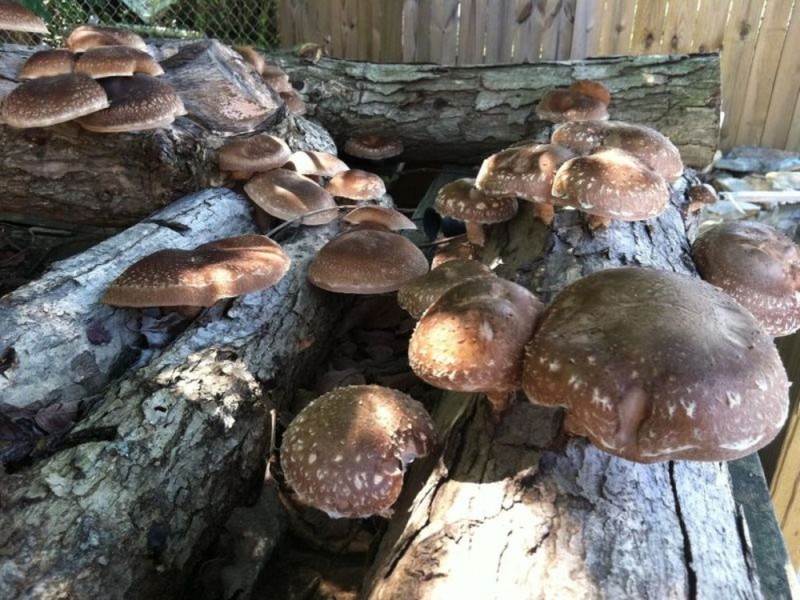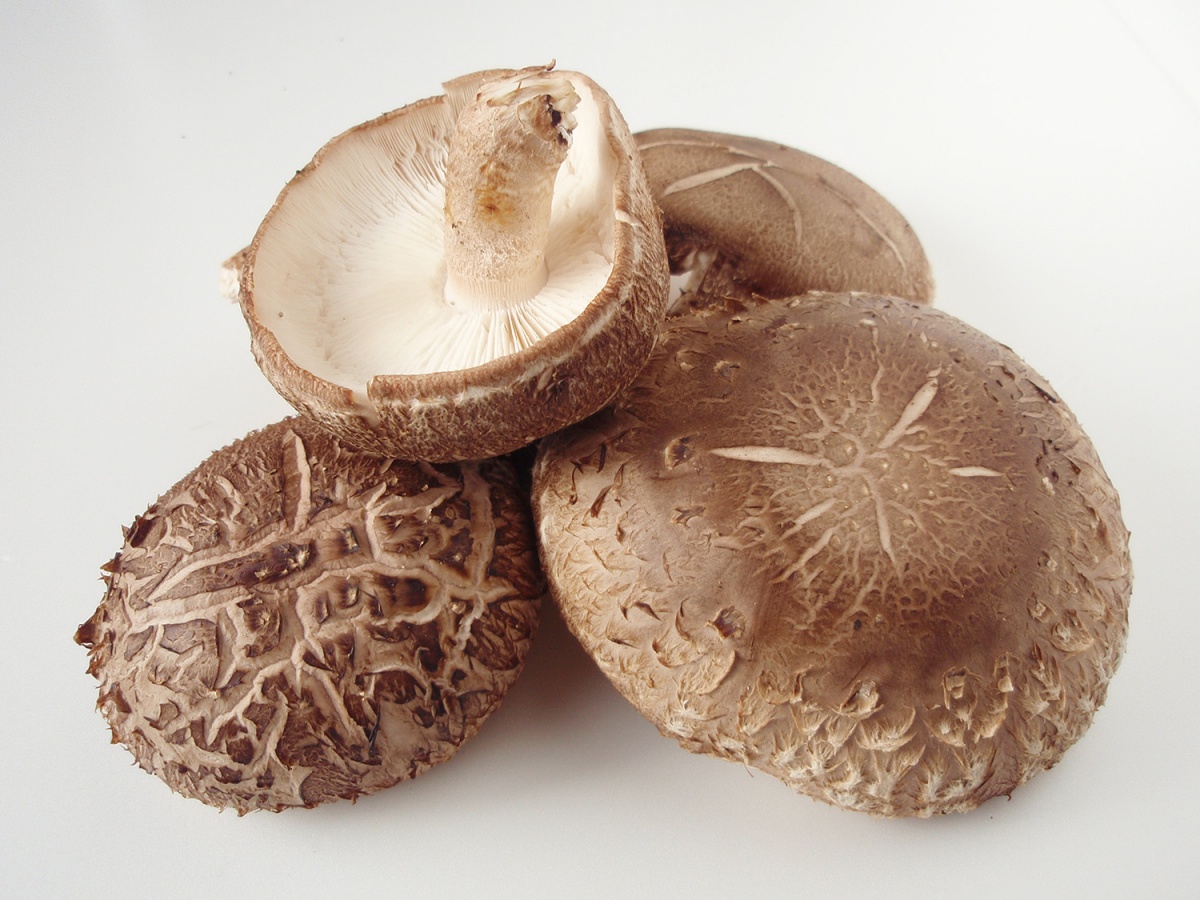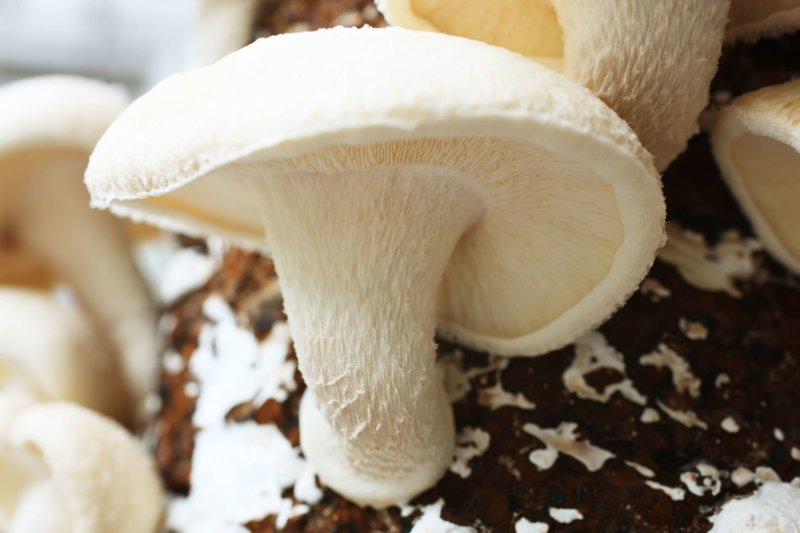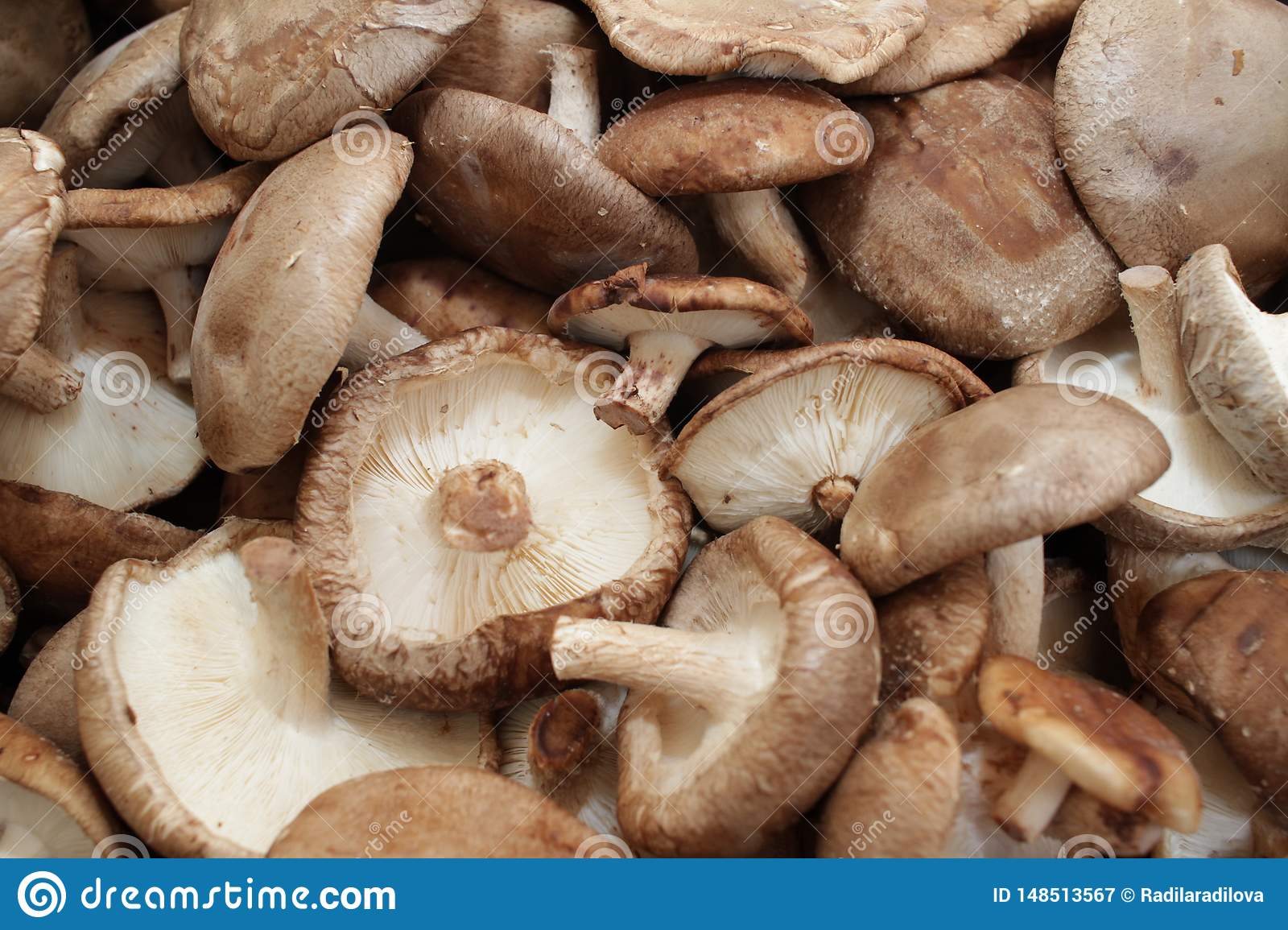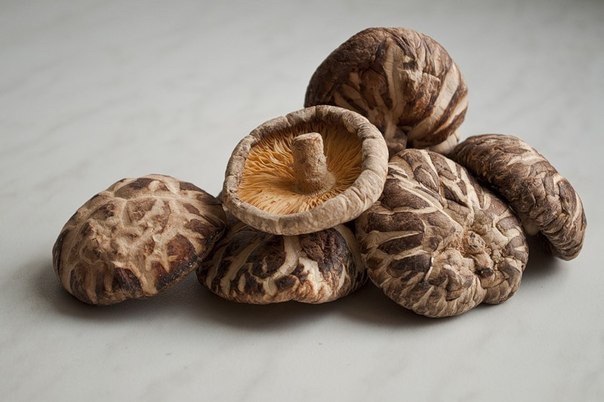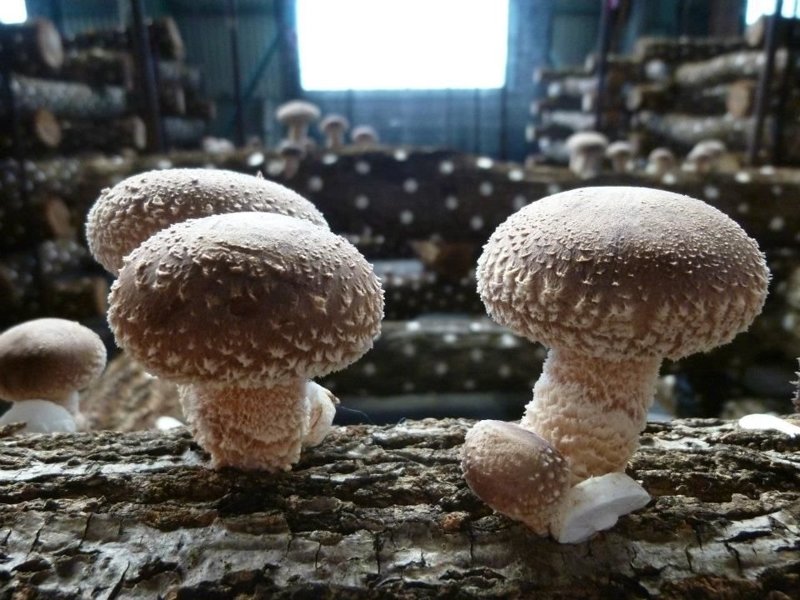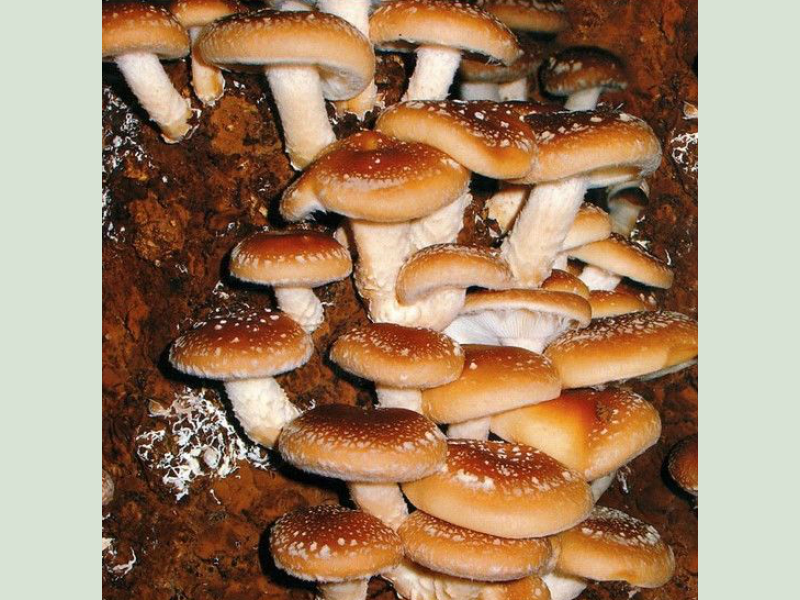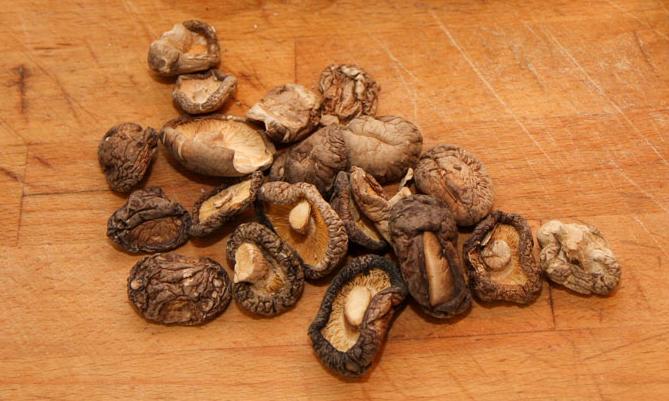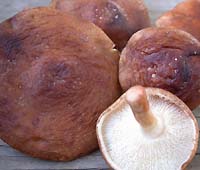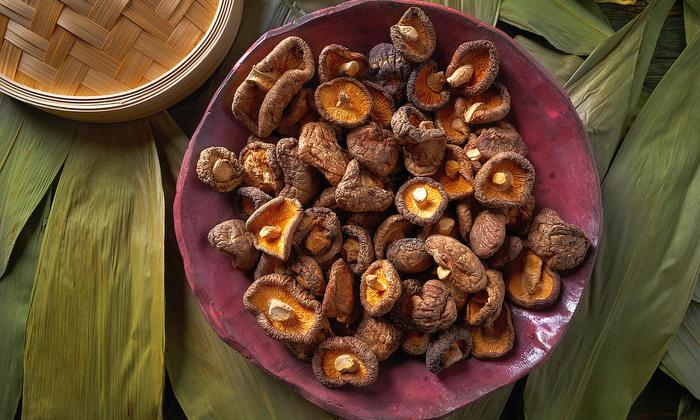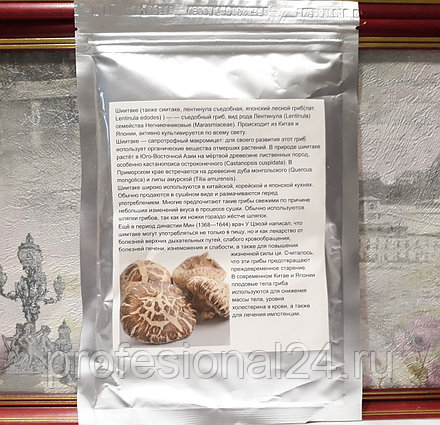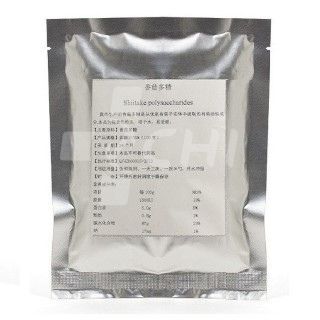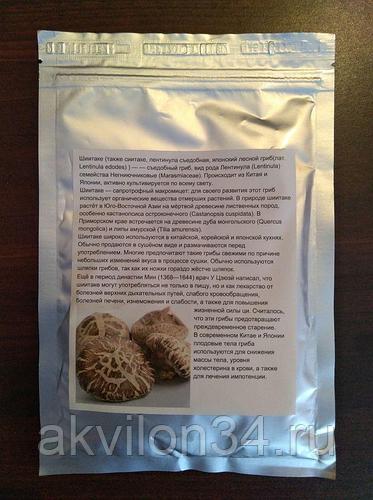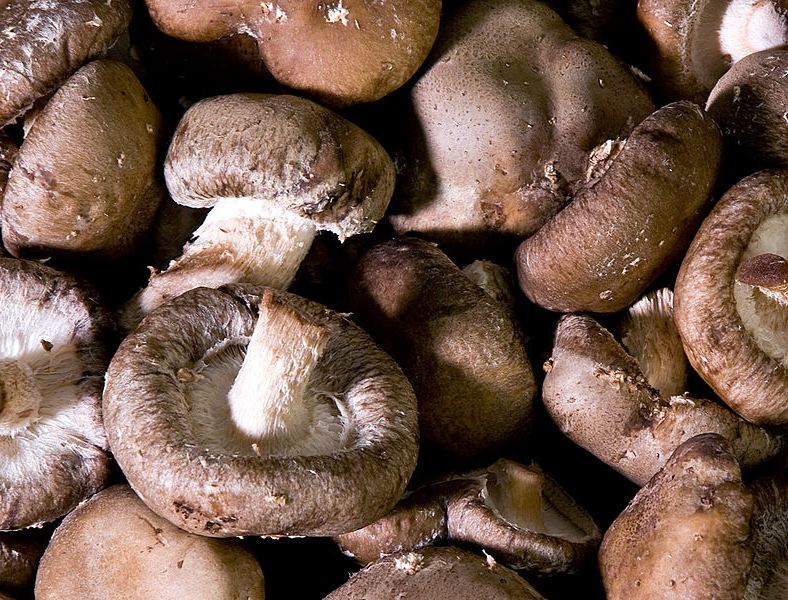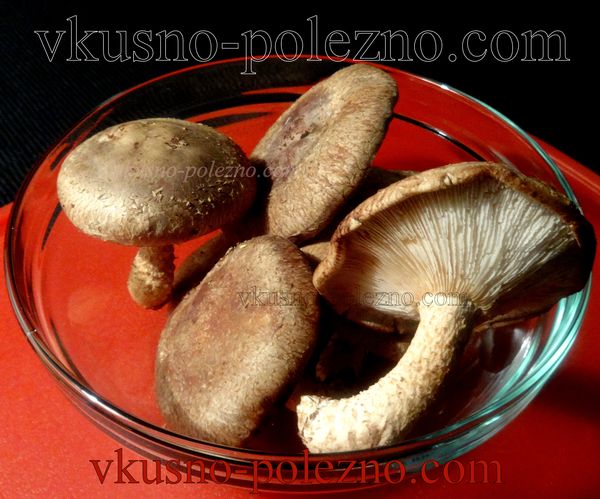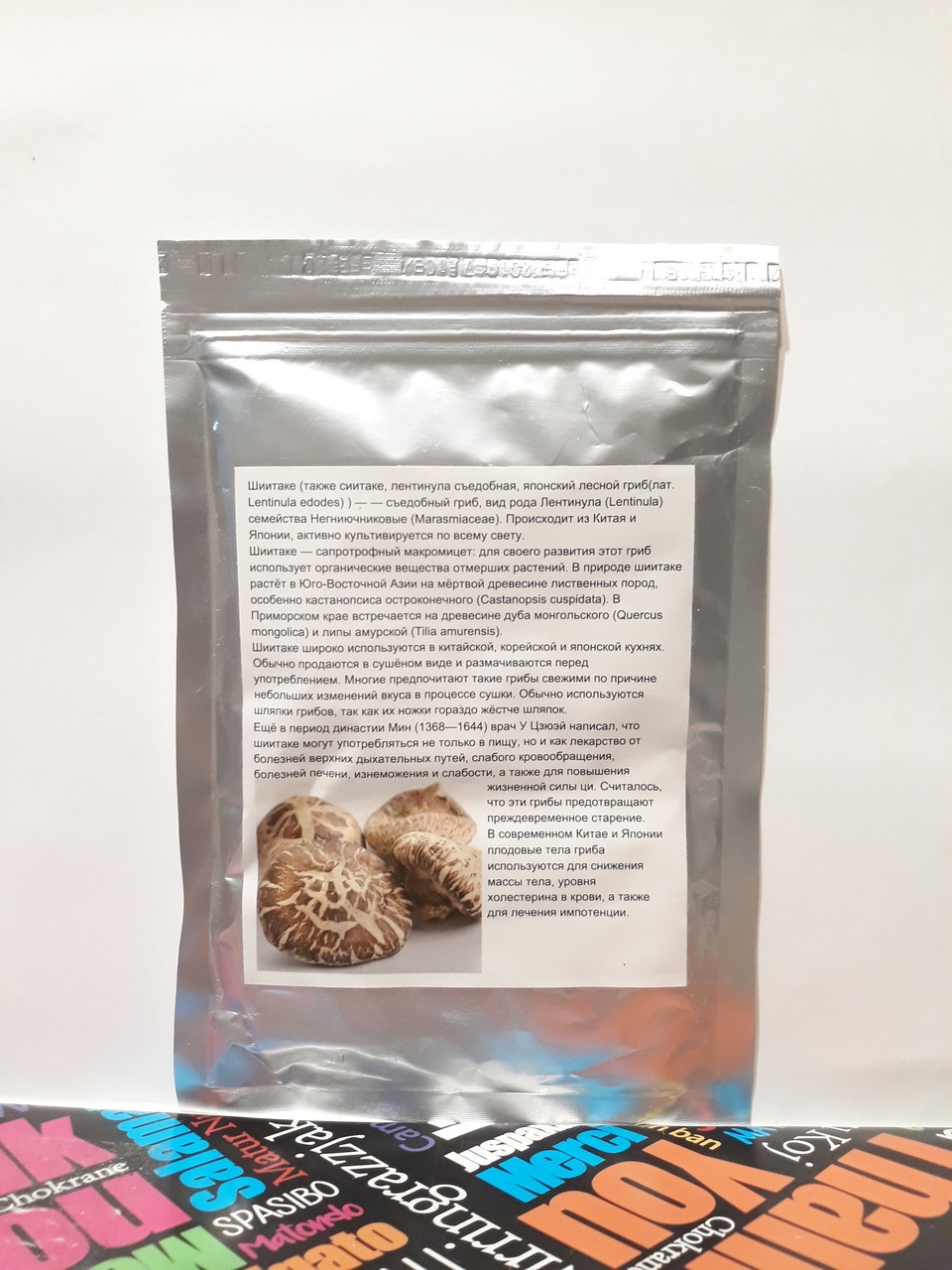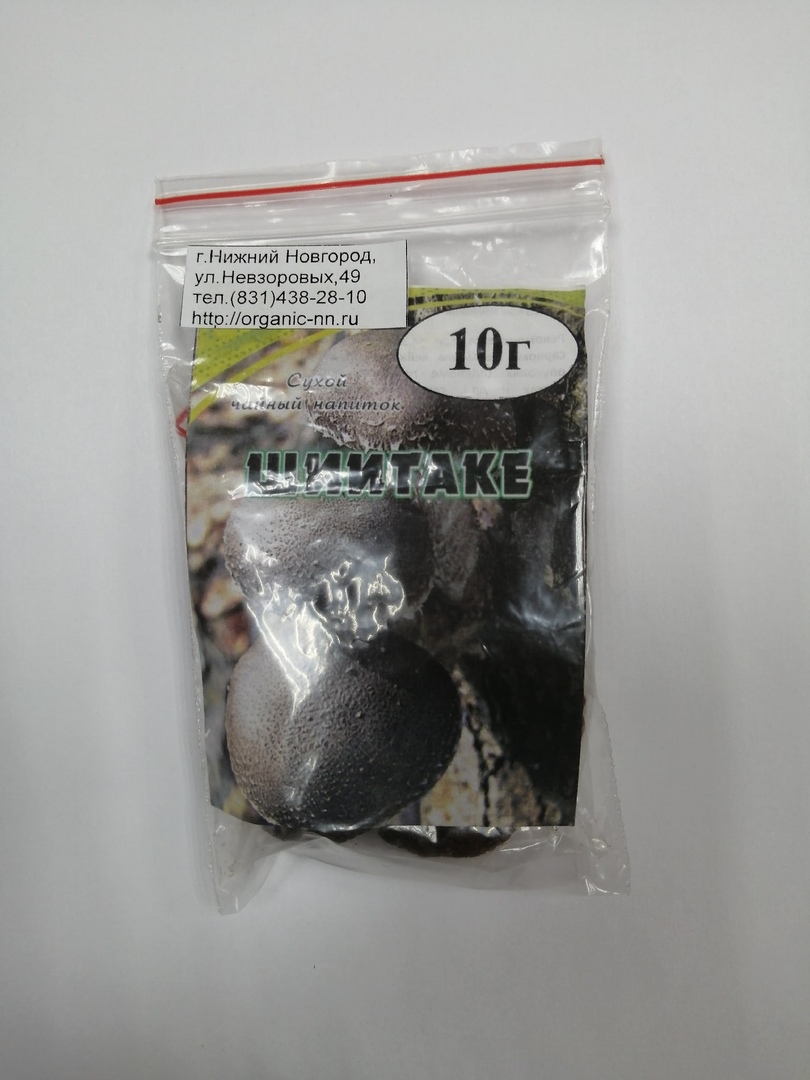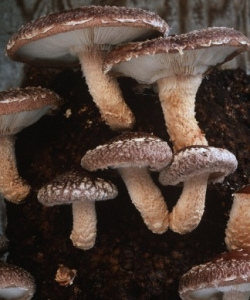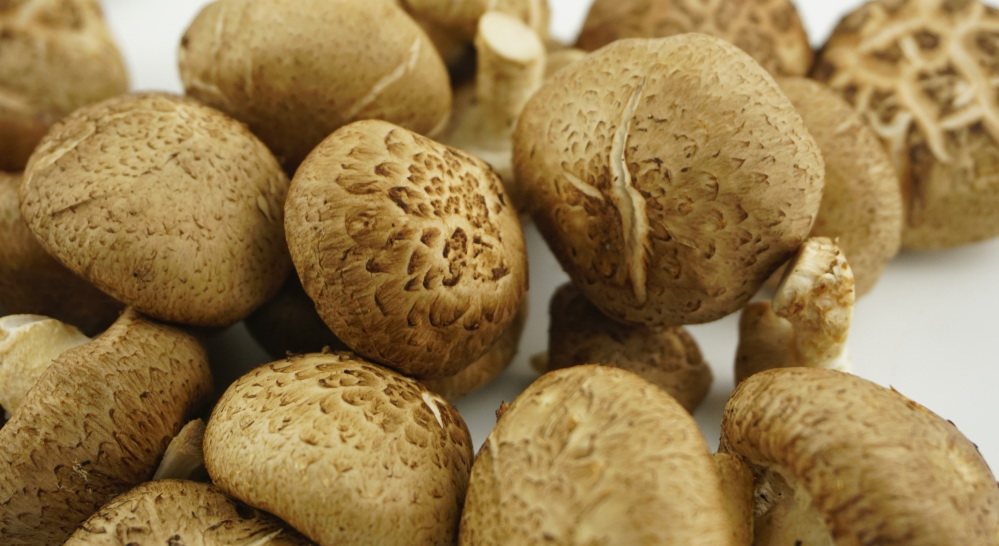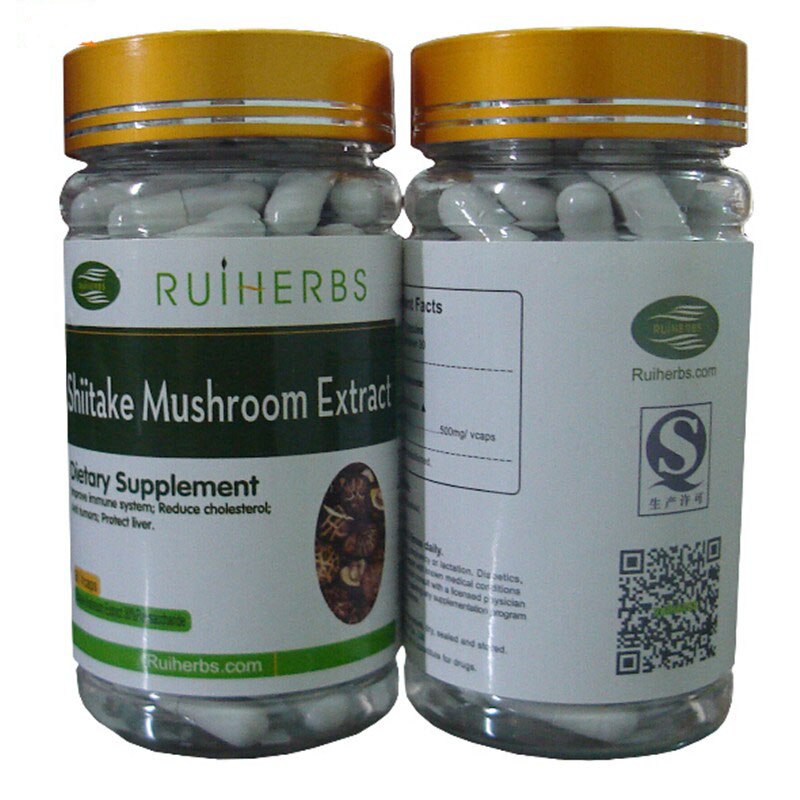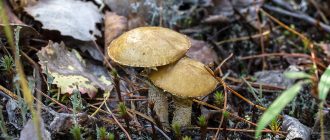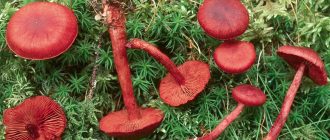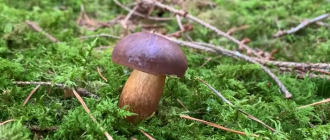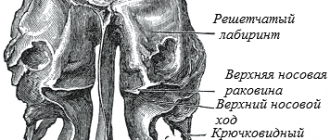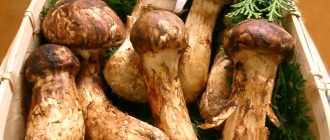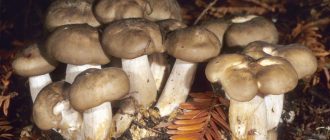Characteristic features of the variety
Shiitake, or lentinula, is an edible mushroom of the non-nut family. Its name comes from two Japanese words: "shii" - dwarf chestnut and "take" - mushroom. That is, it is a mushroom growing on a chestnut. But looking ahead, let's say that this delicacy grows not only on chestnuts and not only in the East. Shiitake mushrooms are also known to Europeans as Chinese or imperial mushrooms.
Appearance, morphology and photo
Shiitaki is difficult to recognize solely by description, so for a start we suggest taking a close look at the photo of this mushroom. Shiitake is usually small. Their caps reach 3 to 15 cm in diameter. In young specimens, they are dark brown, convex hemispherical in shape with a pattern of cracks and seals. The older the lentinula, the flatter and lighter her hat.
Shiitake belong to the lamellar group: under the cap are visible white even or serrated (in older representatives) plates, which turn brown after damage. In young mushrooms, the plates are covered with a protective membrane. The legs of the lentinula are reddish-brown, up to 4 cm in diameter.
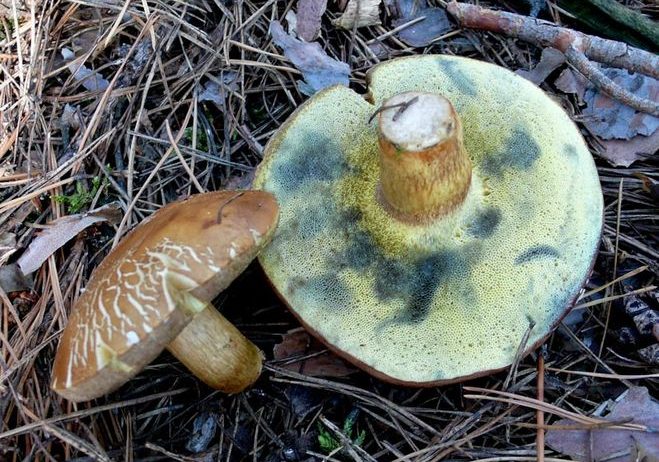 You may be interested in:
You may be interested in:
How to tell if a Polish mushroom is edible or not: useful tips (22 photos)
An interesting and the most striking representative of the genus of Mushrooms is the Polish mushroom. It belongs to the second category ... Read more ...
Place of distribution
Shiitake grows in areas where there is wood, mainly on stumps and trunks. They can appear both in groups and singly, from spring to autumn, usually during the rainy season.
The natural area of the lentinula is the wild forests of Japan and China. Here it can be seen on the trunks of chestnuts, maples, oaks, ebony. In southeast Asia, it grows on dead wood of deciduous trees, most often on spiky castanopsis. Lentinulas are also found in the Primorsky Territory of the Russian Federation, here they can be found on the wood of Mongolian oaks and Amur linden.
Eating
Shiitake is an edible mushroom. In its gastronomic characteristics, it surpasses champignons and oyster mushrooms, but inferior to boletus, although in the East it is considered one of the most delicious. This Japanese delicacy is prepared as a stand-alone dish and is also used as a condiment to sauces, soups, salads and drinks.
In cooking, their hats are more appreciated, since the legs are more rigid and fibrous. Oriental chefs add shredded shiitake to meat and vegetable dishes to add spice and flavor.
 Dried shiitake mushrooms
Dried shiitake mushrooms
Lentinula has a pungent taste and mushroom smell with subtle hints of radish. The peculiarity of this delicacy is that it can be eaten even raw. Boiled, fried or stewed shiitake lose their specific taste and more resemble mushrooms familiar to Europeans.
Important! But you should know that after prolonged heat treatment, part of the vitamins and minerals contained in the delicacy is destroyed. Dried shiitake is much healthier in terms of nutritional value.
Growing history
The earliest written account of the cultivation of Shiitake is found in the Longwan County Records (龍泉 縣志), compiled by Hae Cheng (何 澹) in 1209 during the Southern Song Dynasty. The 185-word description of shiitake cultivation from this literature was later quoted many times and was eventually adapted in a book by the Japanese gardener Sathu Churya (佐藤 中 陵) in 1796, the first book on shiitake cultivation in Japan.
The Japanese cultivated mushrooms by cutting shi trees with axes and placing logs on trees that already had shiitake or shiitake spores. Until 1982, the different types of these mushrooms in the Japanese islands could only be grown in traditional locations using ancient methods.A 1982 report on the budding and growth of a Japanese cultivar showed the potential for commercial cultivation of shiitake in the United States.
Shiitake is now widely cultivated around the world and accounts for about 25% of the total annual mushroom production. Shiitake mushrooms are usually grown commercially in conditions similar to their natural environment, both on artificial substrates and on hardwoods such as oak.
Growing shiitake mushrooms at home
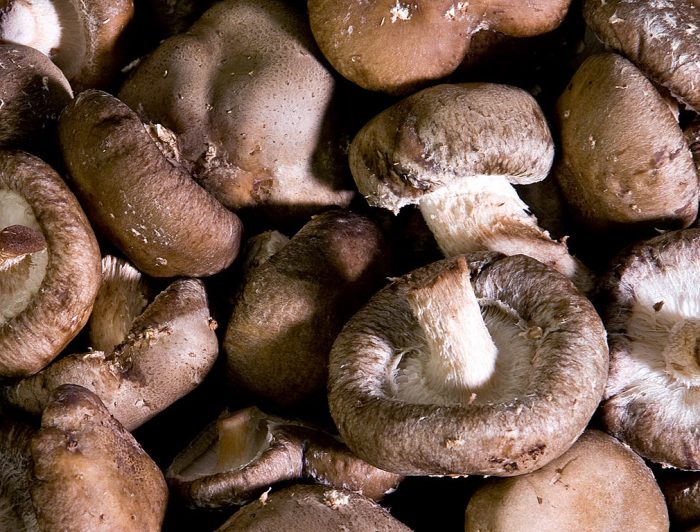
The terms for cultivating shiitake during heat treatment of the substrate on sawdust are shorter than natural cultivation. When using such an intensive technology, fruiting in specially equipped chambers takes place all year round.
The main constituent of shiitake substrates (60-90% of the total mass) are oak, maple or beech sawdust. Alder, birch, willow, poplar and other sawdust are also used. Only sawdust of coniferous trees is not suitable, which contain resins and phenolic substances that stop the growth of the mycelium of the fungus. The optimum particle size of the substrate is 2-3 mm. Very small sawdust disrupts gas exchange in the substrate, which also slows down the development of the fungus. To make the structure of the substrate sufficiently loose, the sawdust is mixed with wood chips. And in order to prevent the development of competitive species of fungi in such a nutrient substrate, it is sterilized or pasteurized. After heat treatment, the mixture is cooled and the mycelium of the fungus is inoculated into it, the container is wrapped in foil.
In order for the mycelium to grow faster and the yield to increase, nutritional supplements are added to the substrate, for example, for this purpose, grain and bran of cereal crops (wheat, barley, rice, millet), flour of leguminous crops, waste from beer production are used. With such feeding, vitamins, macro- and microelements stimulate both mycelium growth and fruiting. Also, chalk or gypsum is added to the substrate to provide it with an optimal level of acidity. All components of the substrate are thoroughly mixed, water is added so that the moisture content is 55-65%.
The mycelium grows for 1.5-2.5 months, in the warmth, after which it is freed from the film or removed from the container and transferred to cool and humid rooms for fruiting. The first crop is harvested within 3-6 months.
Shiitake (mushrooms) - description and photo
The shiitake mushroom has a convex hemispherical cap with a diameter of 5 to 20 cm. The skin on the cap is dry, velvety, covered with few white scales. The color of the cap ranges from various shades of coffee to brownish brown. With age, the shape of the cap of the lentinula edible becomes slightly flattened, and its skin can crack in mature mushrooms. In young mushrooms, the edges of the cap are even, in adult mushrooms, the edge is tucked up, thin and wavy. The maximum weight of a shiitake can reach 90-100 g.

Photo Credit: Batholith
Shiitake plates are thin, frequent, white; in young mushrooms, they are covered with a thin protective membrane.
When pressed and damaged, the plates change color to dark brown.

Photo Credit: Batholith
Shiitake stem is straight, fibrous, slightly tapering towards the base. The height of the leg is from 3 to 19 cm, the diameter usually does not exceed 1.5 cm.
The surface of the stem is light brown or beige, with a clearly visible fringe formed by the remnants of the protective blanket.

Photo Credit: Batholith
Shiitake flesh is dense, fleshy, white or creamy in color, with a pronounced, slightly pungent mushroom taste and a bright, pleasant aroma. Brown spots on the underside of the mushroom indicate the aging of the edible lentinula and the loss of beneficial properties.
The spores are ellipsoidal and white. Like all lamellar mushrooms, they are located on the underside of the cap.
Recipes and cooking features
If oriental culinary specialists cook mainly from fresh mushrooms, then in Europe dried lentinulas are more often used.Japanese and Chinese gourmets claim that after drying shiitake they lose their unique taste and aroma, so they often prefer a product that has not been heat-treated.
 Shiitake dried
Shiitake dried
Europeans, on the other hand, choose an option that is devoid of a specific smell and taste. However, everyone has the right to choose which mushrooms to eat - fresh or after heat treatment.
Fried shiitake with pepper
This dish is very easy to prepare. Required Ingredients:
- 250 g fresh mushrooms;
- 2 bell peppers;
- 2 cloves of garlic;
- 3 tbsp. l. vegetable oil;
- 1 bunch of dill.
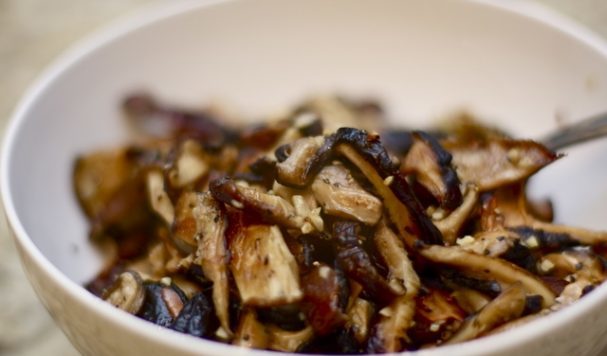 Fried shiitake
Fried shiitake
Remove seeds from pepper, rinse vegetable and cut into strips. Chop the garlic and dill. Peel the mushrooms, cut the caps into slices. Put pepper and mushrooms in a saucepan with heated oil. Stir constantly until cooked. Add garlic, dill and spices, then cook for another 1 minute.
Shiitake soup
Ingredients:
- 150 g fresh shiitake;
- 1 onion;
- 50 g butter;
- 45 ml olive oil;
- 15 g flour;
- 200 ml of milk;
- 300 ml of water;
- salt pepper;
- greens;
- lemon juice.
 Mushroom soup
Mushroom soup
This soup can be cooked from both fresh and pre-dried mushrooms. If you choose the second option, then before cooking, the product must be poured with cold water for 5 minutes. Boil the mushrooms for 40 minutes and chop after cooling. Cut the onion into small cubes, fry in vegetable oil. Mix with mushrooms and fry for another 5 minutes.
Add butter, spices and flour, stirring, until smooth. Pour in water and cook for about 10 minutes, then add milk in a thin stream and bring to a boil. Simmer for 3 minutes over low heat. Let the dish cool slightly, beat in a blender. Serve with herbs, sprinkle with a little lemon juice on top.
The use of shiitake in medicine
Since ancient times, Japanese and Chinese healers have used the shiitake mushroom to treat many diseases. And it turned out they were not far from the truth. The polysaccharide lentinan, secreted from the fruiting body, acts on the liver, accelerating metabolism and the breakdown of fats. This is why shiitake is an important ingredient in weight loss supplements.
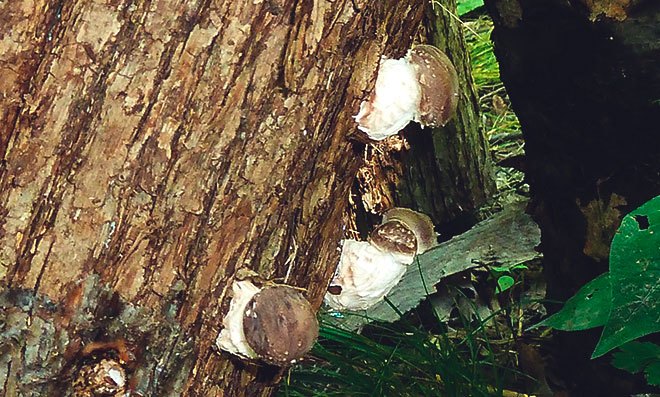
And the high content of vitamins and minerals has a beneficial effect on the body. For medical purposes, a concentrated shiitake extract is used, which has powerful healing effects:
increasing immunity, destroys viruses, bacteria;
stabilizes blood glucose levels (which is important for diabetics);
equalizes pressure;
lowers cholesterol levels;
improves the performance of the liver, kidneys;
prolongs youth, protecting against the harmful effects of free radicals;
increases resistance to stress.
Shiitake-based traditional medicine recipes
In folk medicine, Shiitake is called the elixir of life. A useful mushroom not only strengthens the body, but also relieves many specific diseases, sometimes incurable with the help of traditional medicine. The following remedies are most popular.
Mushroom infusion
It is used for the prevention of cancer. With age, the concentration of the "anti-cancer" enzyme perforin decreases.
But the microelements that make up shiitake increase its level in the body, thereby ensuring the timely destruction of mutated cells.
Cooking method:
- Mix 10 g of shiitake (powder) thoroughly with 0.5 l of vodka / brandy;
- pour into a dark glass container and remove for 2 weeks in a cool place protected from sunlight;
- filter through three times folded gauze and take 1 teaspoon 30 minutes before meals;
- duration of treatment: 1 month (if necessary, it can be repeated after 2 weeks).
Shiitake extract
A well-known remedy for health promotion and normalization of general well-being since ancient times. Doctors of those times used the extract to enhance the effectiveness of medicinal herbs.Now it is used as an independent drug, combined with the intake of chemicals or added to food.
Several centuries ago, the extract was extracted from mushroom legs (they contain the most useful substances). They were boiled over low heat for several hours. Now there is no need for this, because the useful product is sold ready-made.
Oil extractor
They don't make vegetable oil from mushrooms, but oil extract works wonders, relieving diabetes, kidney, joint, oncological and many other diseases.
Cooking method:
- Pour 20 g of dried mushrooms with 50 ml of warm (heated to 37C ° in a water bath) olive oil;
- close the container tightly and put it in a warm battery for 5 days;
- then put in the refrigerator and take without filtering 1 teaspoon twice a day half an hour before meals;
- course of treatment: 1-4 months (after each month, take a break for one and a half weeks).
Healing properties of shiitake
The therapeutic and prophylactic properties of shiitake are undeniable. This explains the popularity of their use as a medicine. In many countries, drugs based on these mushrooms are patented for the treatment of viral and oncological diseases.
Regular use of mushroom infusions, extracts or extracts improves the condition of internal organs, the composition and circulation of blood, supports cardiac activity, etc. But most importantly, the unique composition of the product prevents the development of cancerous tumors.
Do shiitake mushrooms fight cancer?
Research in 1969 examined the effects of shiitake on cancerous tumors. It was then that the polysaccharide lentinan was first isolated. And the scientist T. Ikekawa proved that the element greatly enhances immunity, increasing the body's resistance to many diseases. Among them:
- tumors are malignant and benign;
- blood cancer;
- viruses: hepatitis, HIV, influenza, etc .;
- multiple sclerosis.
By activating the immune system, lentinan helps to recover from chemotherapy. Asian doctors administer injections of the beneficial component as a maintenance therapy for stomach cancer.
Appearance
In the Far East, shiitake mushrooms are also referred to as shiitake mushrooms. They are also known as "imperial mushrooms", having become the property of the peoples of China and Japan. The origin of the Shiitake mushrooms belongs to the genus Lentinula. Fungi also differ in that they feed on the substances of dead vegetation. The average mushroom weight can be up to 100 grams.
The appearance of a shiitake is represented by a hat and a leg. The hat is covered with a dark brown skin. The size of the cap itself can vary from 5 to 20 centimeters in diameter. The plates are thin and covered with a special membrane that protects them from damage. When you click on the plates, their color will change from white to brown. The surface of the cap is presented with small cracks. In young mushrooms, the cap is flat, which takes on a spherical shape with age. This feature can easily determine the age of the Shiitake mushrooms.
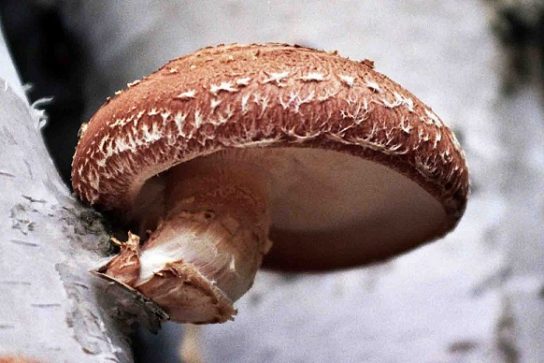
The leg is distinguished by a light shade of brown. In size, the leg can reach from 3 to 19 centimeters in length. The inside of the leg is fibrous. The flesh itself is white and quite firm. The mushroom has a tangy taste with a pleasant aroma.
Distribution and growth season
Shiitake mushrooms grow in mixed, most often oak or beech forests of Southeast Asia, in Primorye. These are saprotrophs and they grow on dead trees, among which the wood of spiky castanopsis, Mongolian oak or Amur linden is highly respected. The best time to collect them is from spring to autumn, after precipitation.

Now the mushroom is actively cultivated, but centuries ago it was grown with great difficulty, since people did not know how shiitake reproduces - they simply rubbed the cuts in the trees. And only in the twentieth century they learned how to grow them correctly.In the 70s, shiitake mushrooms conquered European countries and the United States, becoming very popular in cooking and in medicine.
The healing properties of shiitake
Since ancient times, it was believed that with the regular use of these mushrooms, the state of health improves and the nervous system returns to normal. Shiitake contains a large amount of amino acids.
In Japan and China, shiitake is valued on a par with ginseng. The Japanese believe that shiitake enhances "vital energy", heals colds, satisfies hunger, purifies the blood and improves blood circulation.
Among other types of mushrooms used in medicine, shiitake is the most studied mushroom. In 1969, Dr. Ikekaw conducted research on its medicinal properties. The drug was used on mice with sarcoma, and it showed good results. Shiitake mushrooms produce lentinan, which promotes the formation of perforin, and it inhibits cancer cells. After 35 years of age, natural perforin in the body begins to decline. Today lentinan is registered as an immune drug.
These mushrooms contain water and fat-soluble vitamins: thiamine, biotin, riboflavin, niacin. Shiitake contains a large amount of vitamin D, which is not found in vegetables. There is more of this vitamin in mushrooms than in cod liver. In addition, they are rich in trace elements: potassium, sodium, magnesium, calcium, zinc, phosphorus, selenium, iron, and the like. They even include coenzyme Q10. This is not a complete list of the nutrients found in shiitake mushrooms.

When mushrooms are heat treated, some vitamin content decreases, but when dried, they practically do not change. Scientists have proven that with regular use of shiitaki, the level of cholesterol in the blood decreases, and the risk of developing blood clots, strokes and heart attacks is prevented. In the East, with the help of these mushrooms, they treat diabetes mellitus, strengthen the nervous system, and also remove toxins and toxins from the body.
Shiitake is used in complex therapy against hepatitis, respiratory diseases, nervous pathologies, skin problems and even oncology. In addition, these mushrooms improve the functioning of the digestive system, and also actively break down fats, therefore they are used for weight loss.
The culinary value of shiitake mushrooms
Many authors note that shiitake tastes better than oyster mushrooms and mushrooms, but it is less tasty than boletus mushroom.

But the Japanese give shiitake first place among other mushrooms. They especially appreciate soups made from fresh shiitake or powder. Europeans sometimes do not like the slightly spicy taste of these mushrooms, but people who are used to shiitake like them very much.
Fresh shiitake has a pleasant mushroom aroma, while they have a weak radish flavor. If the mushrooms are dried at 60 degrees, they smell even better. Shiitake can be eaten fresh, without prior boiling. When fried or boiled, these mushrooms become less pungent. Shiitake legs are significantly less tasty than caps and are also more fibrous.
Similar species
Externally, shiitaki mushroom can be confused with meadow mushroom, or pepper pot or common mushroom. This similarity is not dangerous, because the Meadow mushroom is a tasty and healthy mushroom. In terms of taste, it belongs to the 2nd category. These mushrooms are used pickled, fried and boiled.
The diameter of a common champignon's cap is 8 to 15 centimeters. At first, the shape of the cap is spherical with a wrapped edge and closed plates, and then it becomes convex-outstretched. The surface of the cap is silky, dry; in adulthood, small brown scales in the center can be observed. The color of the cap is white, and over time it becomes brownish. On the cut, the pulp turns a little pink. The leg is 3-10 centimeters long and 1-2 centimeters thick. The leg is even, cylindrical, fibrous, solid, and can taper or expand towards the base. The color of the leg is brownish. There is a wide thin ring on the leg.

Meadow mushrooms bear fruit from May to September. They grow in open landscapes on humus-rich soils. They are especially numerous after the rains. Meadow mushrooms can be found in pastures, meadows and forest edges.
The appearance of the imperial mushroom
Hat: hemispherical shape, reaching a diameter of 15-20 cm. The skin of the hat is delicate, smooth, covered with numerical white flakes (scales), color from light, coffee to dark brown.

In adults, the cap becomes covered with cracks, its edge is bent inward and becomes thinner. The weight of a mature mushroom becomes about 100 g.

The plates under the cap of the mushroom are numerical, clean, thin. The damaged plates soon darken.

The fungus has a straight, fibrous stem. Its dimensions become 4-15 cm in height and 2 cm in diameter. The color range ranges from beige and cream to brown.


Disputes are light, oval, located at the bottom of the cap.

We suggest looking at the photos of the Shiitake mushroom below.


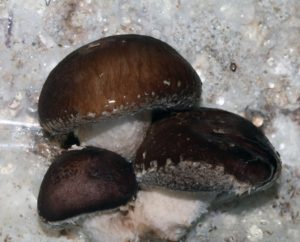
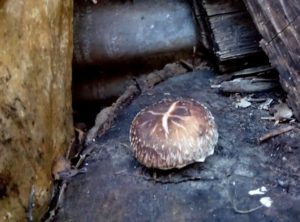


Similar species and how to distinguish from them
Shiitake mushrooms are difficult to confuse with any others. An experienced mushroom picker will easily notice the differences, but a newcomer to the mushroom world may not distinguish it from dark red champignon (Agaricus haemorroidarius), forest champignon (Agaricus silvaticus) and August mushroom (Agaricus augustus) due to the presence of both scales on the cap. But in fact, these species have one main difference: if the former grows on dead trees, then champignons grow on humus-rich soils in forests or parks.
It is also worth paying attention to the season of the year - basically, these mushrooms grow in summer and autumn, while shiitake can be harvested in spring. Fortunately, if in some way there was confusion, then this is not scary, since champignon is an edible and very tasty and healthy mushroom, therefore, poisoning to an inexperienced lover of "quiet hunting" is not threatened here in any case
Interesting facts about the mushroom
Eating shiitake food is a long-standing tradition of the Chinese and Japanese people. These mushrooms have been grown for over a thousand years. And already in ancient China and Japan it was known that shiitake is not only a food product, but can also be used as a medicine for diseases of the upper respiratory tract, poor circulation, liver diseases, exhaustion and weakness, to increase vital energy. Shiitake was believed to prevent premature aging. Today, the fruiting bodies of shiitake in Japan and China are used for the purpose of losing weight, lowering blood cholesterol levels, and in the treatment of impotence.
Shiitake mycelium extract has protective properties during chemotherapy, and reduces the number of pathologically altered cells that appear under the action of anticancer drugs. In 1969, the anticancer drug lentinan was isolated from shiitake.
The global production of shiitake mushrooms at the beginning of the 21st century reached 800 thousand tons per year.
Rate
Shiitake (lat. Lentinula edodes) is a mushroom of the non-nut family, suitable for eating. This curiosity came to our stores from the very Middle Kingdom (Japan). 


How to cook shiitake?
The legs of the Japanese mushroom are rarely eaten because of their rigid fibrous structure, and only soft, delicate caps are cut off. In Asia, shiitake mushrooms are processed immediately after harvest, and Europeans dry these mushrooms, and then soak and cook, if necessary. But, according to Asians, dry shiitake dishes are losing their unique, tangy flavor. Aromatic soups and sauces are prepared from edible lentinula, mushrooms are served as a side dish for meat, fish or as an independent delicacy dish, added to marinades and broths, they are fried and salted. And connoisseurs of "live" and piquant mushroom taste eat this mushroom without any heat treatment at all.

Photo Credit: CostaPPPR
Useful properties of shiitake and restrictions on use
Shiitake is a treasure trove of vitamins, minerals and other health-promoting components.Therefore, the imperial delicacy is widely used not only in cooking, but also in alternative medicine.
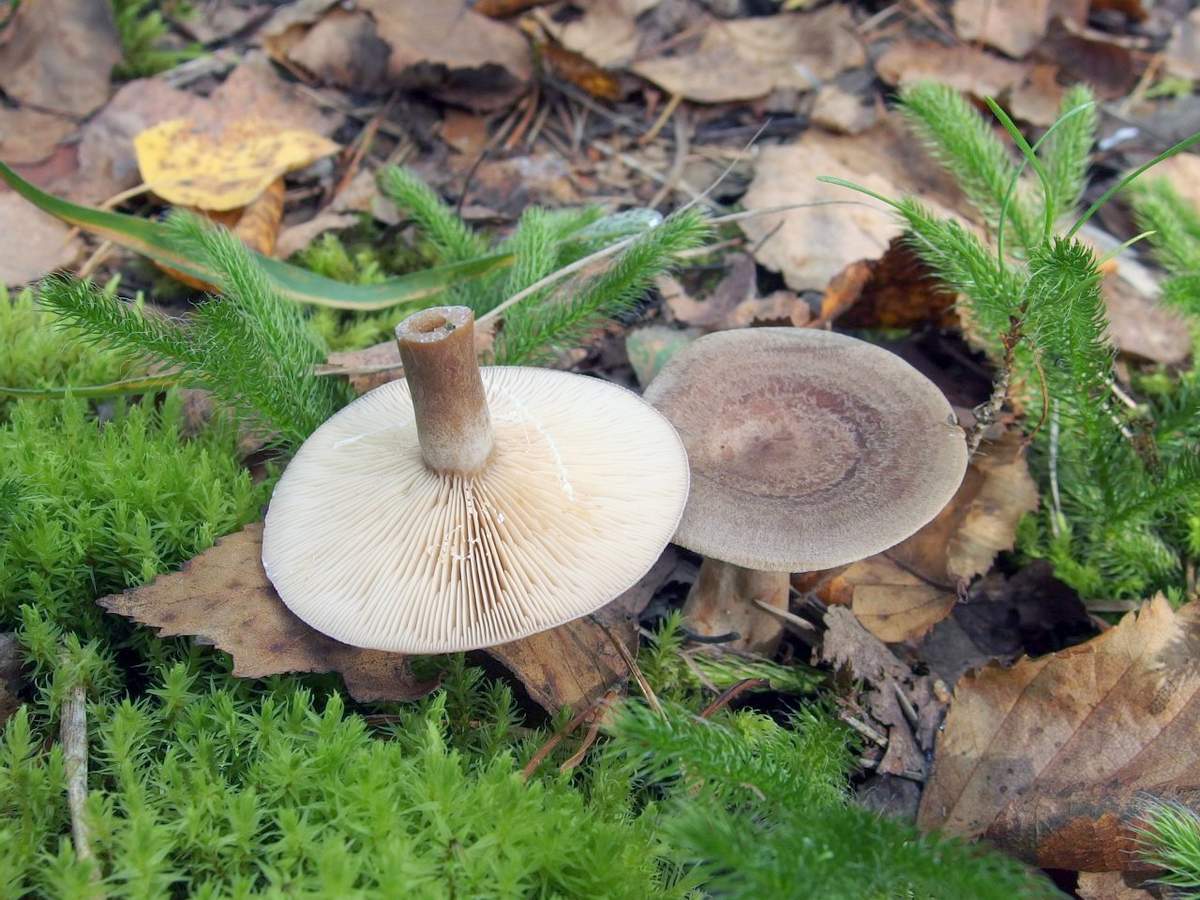 You may be interested in:
You may be interested in:
How to distinguish real mushrooms from false mushrooms (28 photos)?
Ryzhiki is a popular forest delicacy in our country with an exquisite taste. They are not inferior in their gustatory qualities ... Read more ...
Nutritional value
Lentinula is characterized by high nutritional value, and all of its many beneficial properties are determined by its extremely rich chemical composition.
Shiitake satisfies hunger well and gives the body the necessary energy. 100 g of fresh product contains about 30 kcal, the same portion of a boiled delicacy contains about 40 kcal, and dried - 300 kcal. It is an excellent source of proteins (almost 10 g per 100 g of dry product), amino acids essential for humans, as well as many vitamins, micro- and macroelements.
By the way, there are more amino acids in this product than in legumes, chestnuts or corn, and in terms of vitamin D content (in terms of dry weight), shiitake even surpasses cod liver.
Eating an imperial delicacy, you can be sure that the body will receive many useful substances, such as:
- B vitamins;
- vitamin D;
- zinc;
- potassium;
- calcium;
- iron;
- magnesium;
- manganese;
- phosphorus;
- sodium;
- chitin and others.
All of them are indispensable for the proper functioning of the human body.
Healing properties of shiitake
The healing properties of shiitake were known in ancient China. In the old days, emperors used mushroom broth, believing that this remedy helps to maintain youth and prevents disease. Since ancient times, lentinula was also appreciated in Japan, where it was called the elixir of life and was respected along with ginseng. Today, shiitake extract is used as an active ingredient in anti-aging cosmetics. By the way, they say that the secret of the beautiful skin of Japanese geishas lies precisely in the lentinula.
When consumed regularly, Shiitake has a number of benefits for the body:
- improve overall health;
- tone up the nervous system;
- treat colds;
- purify the blood;
- lower cholesterol levels;
- normalize blood sugar levels;
- have a beneficial effect on the work of the digestive tract;
- increase resistance to stress;
- remove toxins from the body;
- relieve fever;
- increase male potency.
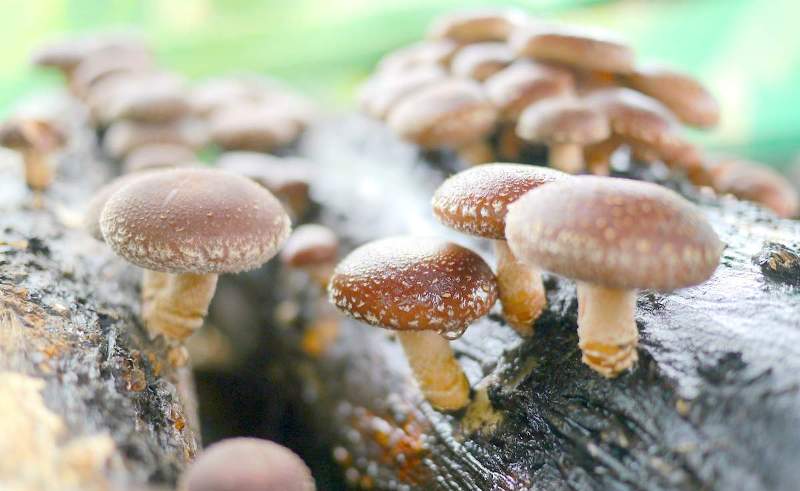 Useful properties of shiitake
Useful properties of shiitake
Lentinula-based dishes and medicines are useful if you have:
- high cholesterol;
- diseases caused by reduced immunity;
- diabetes mellitus;
- viral diseases (herpes, flu, smallpox, polio, hepatitis, HIV);
- diseases of a bacterial nature (bronchitis, tuberculosis, coccal flora);
- cardiac disorders (atherosclerosis, coronary heart disease, hypertension, a tendency to thrombosis);
- candidiasis;
- ophthalmic disorders;
- some types of cancer;
- peptic ulcer of the gastrointestinal tract;
- gout;
- constipation;
- liver disease;
- diseases of the upper respiratory tract;
- obesity.
Interesting! In addition, it is believed that with the help of lentinula it is possible to neutralize snake venom in the body, as well as to treat cancer.
For the prevention of malignant tumors, an alcoholic infusion of shiitake is taken. The medicine is prepared from 60 g of mushroom powder and 800 ml of vodka. The mixture is infused in a cool place for 30 days. Consume 1 teaspoon before each meal for a month, then take a break.
For most other diseases, it is advised to consume dried mushroom powder. The daily portion of natural medicine is 6-16 g. The powder can be consumed both raw and added to soups or made into a decoction. To strengthen immunity and increase tone, it is also useful to drink mushroom powder: 1 tsp. three times a day before meals, the course is 1 month.
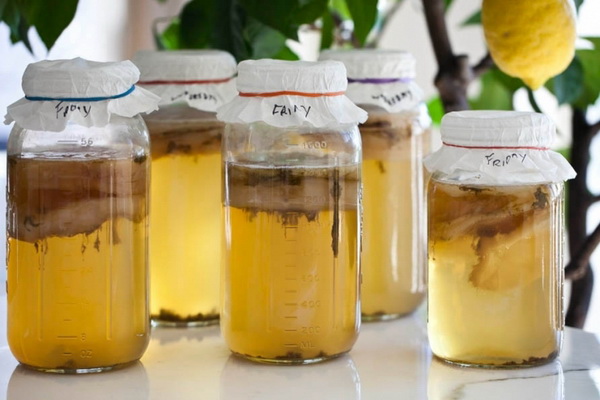 Mushroom infusion
Mushroom infusion
For cosmetic purposes, an infusion of mushrooms is used. 2 parts of water and 1 part of chopped mushrooms are infused in a dark place from a week to 10 days. With this tool, it is useful to wipe problem and aging skin every day.
Despite the huge list of benefits, shiitake also has contraindications. So, the imperial delicacy should not be consumed by children under 7 years old, asthmatics, people prone to allergies, as well as pregnant women and women during lactation.


